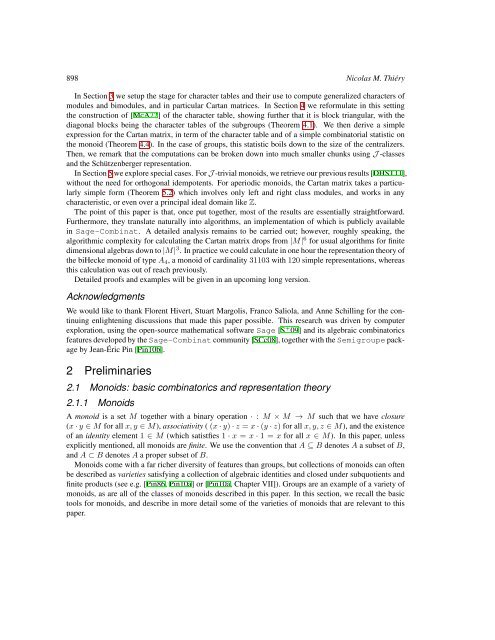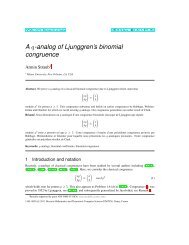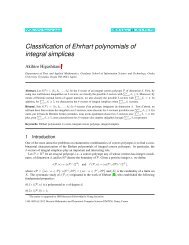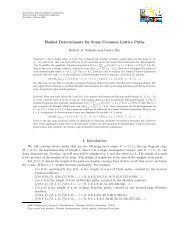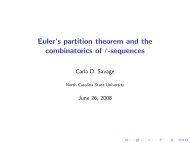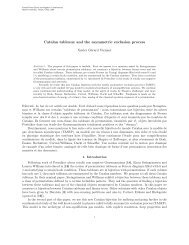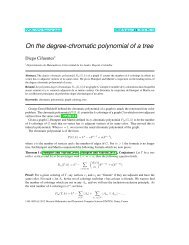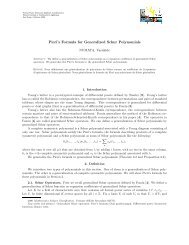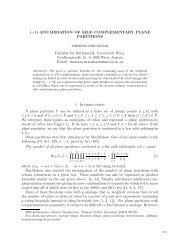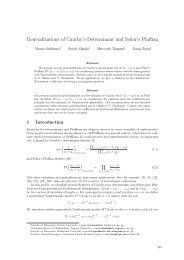Cartan invariant matrices for finite monoids - Nagoya University
Cartan invariant matrices for finite monoids - Nagoya University
Cartan invariant matrices for finite monoids - Nagoya University
You also want an ePaper? Increase the reach of your titles
YUMPU automatically turns print PDFs into web optimized ePapers that Google loves.
898 Nicolas M. Thiéry<br />
In Section 3 we setup the stage <strong>for</strong> character tables and their use to compute generalized characters of<br />
modules and bimodules, and in particular <strong>Cartan</strong> <strong>matrices</strong>. In Section 4 we re<strong>for</strong>mulate in this setting<br />
the construction of [McA72] of the character table, showing further that it is block triangular, with the<br />
diagonal blocks being the character tables of the subgroups (Theorem 4.1). We then derive a simple<br />
expression <strong>for</strong> the <strong>Cartan</strong> matrix, in term of the character table and of a simple combinatorial statistic on<br />
the monoid (Theorem 4.4). In the case of groups, this statistic boils down to the size of the centralizers.<br />
Then, we remark that the computations can be broken down into much smaller chunks using J -classes<br />
and the Schützenberger representation.<br />
In Section 5 we explore special cases. For J -trivial <strong>monoids</strong>, we retrieve our previous results [DHST11],<br />
without the need <strong>for</strong> orthogonal idempotents. For aperiodic <strong>monoids</strong>, the <strong>Cartan</strong> matrix takes a particularly<br />
simple <strong>for</strong>m (Theorem 5.2) which involves only left and right class modules, and works in any<br />
characteristic, or even over a principal ideal domain like Z.<br />
The point of this paper is that, once put together, most of the results are essentially straight<strong>for</strong>ward.<br />
Furthermore, they translate naturally into algorithms, an implementation of which is publicly available<br />
in Sage-Combinat. A detailed analysis remains to be carried out; however, roughly speaking, the<br />
algorithmic complexity <strong>for</strong> calculating the <strong>Cartan</strong> matrix drops from |M| 6 <strong>for</strong> usual algorithms <strong>for</strong> <strong>finite</strong><br />
dimensional algebras down to |M| 3 . In practice we could calculate in one hour the representation theory of<br />
the biHecke monoid of type A 4 , a monoid of cardinality 31103 with 120 simple representations, whereas<br />
this calculation was out of reach previously.<br />
Detailed proofs and examples will be given in an upcoming long version.<br />
Acknowledgments<br />
We would like to thank Florent Hivert, Stuart Margolis, Franco Saliola, and Anne Schilling <strong>for</strong> the continuing<br />
enlightening discussions that made this paper possible. This research was driven by computer<br />
exploration, using the open-source mathematical software Sage [S + 09] and its algebraic combinatorics<br />
features developed by the Sage-Combinat community [SCc08], together with the Semigroupe package<br />
by Jean-Éric Pin [Pin10b].<br />
2 Preliminaries<br />
2.1 Monoids: basic combinatorics and representation theory<br />
2.1.1 Monoids<br />
A monoid is a set M together with a binary operation · : M × M → M such that we have closure<br />
(x · y ∈ M <strong>for</strong> all x, y ∈ M), associativity ( (x · y) · z = x · (y · z) <strong>for</strong> all x, y, z ∈ M), and the existence<br />
of an identity element 1 ∈ M (which satistfies 1 · x = x · 1 = x <strong>for</strong> all x ∈ M). In this paper, unless<br />
explicitly mentioned, all <strong>monoids</strong> are <strong>finite</strong>. We use the convention that A ⊆ B denotes A a subset of B,<br />
and A ⊂ B denotes A a proper subset of B.<br />
Monoids come with a far richer diversity of features than groups, but collections of <strong>monoids</strong> can often<br />
be described as varieties satisfying a collection of algebraic identities and closed under subquotients and<br />
<strong>finite</strong> products (see e.g. [Pin86, Pin10a] or [Pin10a, Chapter VII]). Groups are an example of a variety of<br />
<strong>monoids</strong>, as are all of the classes of <strong>monoids</strong> described in this paper. In this section, we recall the basic<br />
tools <strong>for</strong> <strong>monoids</strong>, and describe in more detail some of the varieties of <strong>monoids</strong> that are relevant to this<br />
paper.


